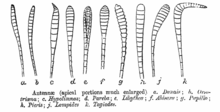| Revision as of 20:59, 7 November 2006 edit202.36.134.22 (talk) reword← Previous edit | Revision as of 16:35, 8 November 2006 edit undoStemonitis (talk | contribs)Extended confirmed users179,488 edits finer cat.Next edit → | ||
| Line 15: | Line 15: | ||
| ] | ] | ||
| ] | |||
| ] | ] | ||
Revision as of 16:35, 8 November 2006
For other uses, see Antenna.
Antennae (singular antenna) are paired appendages connected to the front-most segments of arthropods. In crustaceans, they are biramous and present on the first two segments of the head, with the smaller pair known as antennules. All other arthropod groups, except chelicerates and proturans which have none, have a single, uniramous pair of antennae.
Antennae are jointed, at least at the base, and generally extend forward from the head. They are sensory organs, although the exact nature of what they sense and how they sense it is not the same in all groups, nor always clear. Functions may variously include sensing touch, air motion, heat, vibration (sound), and especially olfaction (smell or taste).
In insects, olfactory receptors on the antennae bind to odour molecules, including pheromones. The neurons that possess these receptors signal this binding by sending action potentials down their axons to the antennal lobe in the brain. From there, neurons in the antennal lobes connect to mushroom bodies that identify the odour. The sum of the electrical potentials of the antenna to a given odor can be measured using an electroantenogram.

The three basic segments of the typical insect antenna are the scape (base), the pedicel (stem), and finally the flagellum, which often comprises many units known as flagellomeres (the number of flagellomeres can vary greatly, and is often of diagnostic importance). True flagellomeres have a membranous articulation between them, but in many insects, especially the more primitive groups, the flagellum is entirely or partially composed of a flexible series of small annuli, which are not true flagellomeres. In many beetles and in the chalcidoid wasps, the apical flagellomeres form a club, and the collective term for the segments between the club and the antennal base is the funicle (or funiculus); for traditional reasons, in beetles it is the segments between the club and the scape, but in wasps, it is the segments between the club and the pedicel. In the groups with more uniform antennae (for example: Diplopoda), all segments are called antennomeres. Some groups have a simple or variously modified apical or subapical bristle called an arista (this may be especially well-developed in various Diptera).
